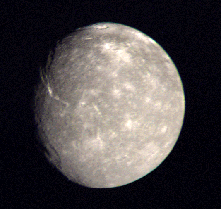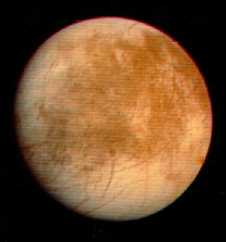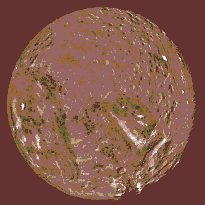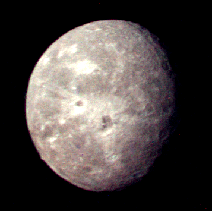This is an image of Titania.
Click on image for full size
NASA
Titania
Titania was discovered by W. Herschel in 1787. Titania is about as wide as the state of California is long.
The surface features of this moon are hard to see in this image. The surface suggests that Titania one of the icy moons.
You might also be interested in:

The surface of Titania is like many icy moons. It does not have many craters. Instead it has grooves similar to those found on Ganymede. These grooves extend for many kilometers over the surface.
...more
Icy moons are moons which are made of ice. These moons are unlike the earth's moon, which is made of rock. Perfect examples of icy moons are 3 of the Galilean satellites, Europa, Ganymede, and Callisto.
...more
Uranus has // Call the moon count function defined in the document head print_moon_count('uranus'); interesting moons and a ring system. At Uranus there is even a half ring, or "ring arc". The moons are
...more
Miranda was discovered by G. Kuiper in 1948. Miranda one of the smallest icy moons, and is as wide as the distance from Los Angeles to San Francisco. The surface features of this moon are hard to see in
...more
The surface of Miranda is very unusual. It is not like any other moon in the solar system. Miranda has many craters but also very big grooves. These show that there has been activity inside Miranda in
...more
Oberon was discovered by W. Herschel in 1787. Oberon is about as wide as the state of California is long. Oberon is probably one of the icy moons.
...more
The surface of Oberon is like many icy moons. It appears to be changed for it does not have many craters. Instead it has grooves similar to those found on Ganymede. These grooves extend for ma ny kilometers
...more
The surface of Oberon is like many icy moons. It appears to be changed for it does not have many craters. Instead it has grooves similar to those found on Ganymede. These grooves extend for ma ny kilometers
...more










